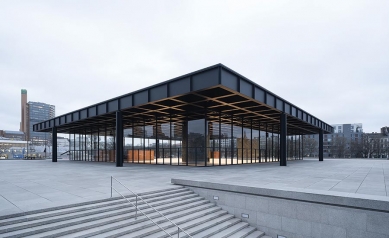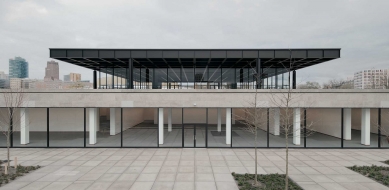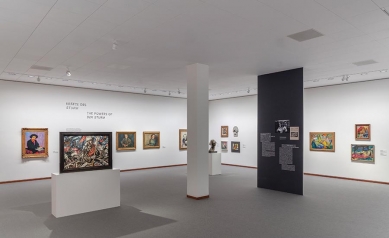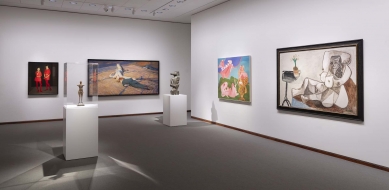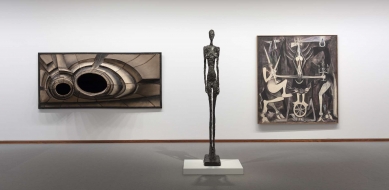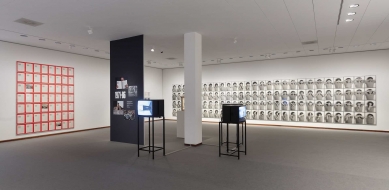
Střet umění a politiky: Berlínská výstava v Miesově galerii
Pořadatel
Neue Nationalgalerie Berlin
Místo konání
Potsdamer Str. 50, Berlín, Německo
Start
sat 18.11.2023 10:00
End
sun 28.9.2025 18:00
vernissage
sat 18.11.2023 15:00
Odkaz
www.smb.museum ...
Neue Nationalgalerie Berlin
Místo konání
Potsdamer Str. 50, Berlín, Německo
Start
sat 18.11.2023 10:00
End
sun 28.9.2025 18:00
vernissage
sat 18.11.2023 15:00
Odkaz
www.smb.museum ...
Exhibitions
Germany
Berlin
Ludwig Mies van der Rohe
David Chipperfield
Publisher
Petr Šmídek
Petr Šmídek
Since November of last year, a large and successful exhibition titled Zerreissprobe (translated as Stress Test) has been on display in the New National Gallery in Berlin, showcasing the complex relationship between art, politics, and society after 1945. It is now offered to visitors until September of this year. The exhibition presents works from West and East Germany, Western Europe, the USA, and former socialist countries.
Very few epochs have been so strongly defined by division, dislocation, and transformation as the period after World War II. The Holocaust and World War II, unrest and emancipation, the Cold War, and the fall of the Berlin Wall — all of these led not only to tensions in society but also to a fundamental turning point in visual art. At the same time, these events became an inspiration for artists, giving them reasons for reflection and often leading them to redefine their work.
The exhibition compellingly points out how this conflicting period permeated with politics and society had a profound influence on the shaping of art, not only for its time but also for subsequent generations. The selection of works covers the post-war period until the turn of the millennium. The exhibition focuses on central artistic and social themes of the 20th century in 14 sections, highlighting key movements such as realism, expressionism, pop art, minimal art, conceptual art, contemporary art, and video art. For example, one can see how artists reacted to the horrors of war and the Holocaust after 1945. Fear and inner unrest are reflected, for instance, in the thin, elongated figures of Swiss sculptor Alberto Giacometti. Visitors can also navigate the exhibition with an audio recording that intuitively guides them through, providing information about the artists, moments from German history, and social discourses.
The New National Gallery, where the exhibition takes place, is an architectural icon of modernism designed by Mies van der Rohe. It is located near Potsdamer Platz and houses a significant collection of 20th-century art, including works by Edvard Munch, Pablo Picasso, and Francis Bacon. The museum hall, flooded with light, has fascinated visitors with its unique construction since it was built — the building is designed as a square pavilion with a steel structure featuring eight columns and a glass façade all around, supporting a monumental coffered roof. Daylight and its transformation throughout the year is a dominant element in shaping the overall impression of both the space itself and the exhibited artworks, which can also be observed from outside. Temporary exhibitions take place in the main hall, while the permanent collection is located on the lower level. In the adjacent outdoor garden, which is part of the original architectural concept, sculptures by prominent sculptors like Henry Moore, George Rickey, and Eduardo Chillida can be seen.
The history of the Neue Nationalgalerie is inextricably linked to the political division of Germany and the city of Berlin, which occurred as a result of World War II. In 1962, Mies van der Rohe was commissioned to design a new museum building that would house both a collection of 19th-century art and a "Gallery of the 20th Century." In September 1965, the architect came to Berlin to lay the cornerstone. Two years later, he also personally took part in the grandest phase of construction: the hydraulic lift of the gigantic steel roof. The building was opened on September 15, 1968, and was named the Neue Nationalgalerie (New National Gallery). Its name signaled a departure from the old and the beginning of a new chapter in the cultural renaissance of West Berlin.
In 2015, the gallery was closed for a complete revitalization and reconstruction. The challenging project was entrusted to David Chipperfield Architects. During the renovations, over 35,000 components were removed from the building and subsequently restored. A new granite floor was laid throughout, and 1,600 square meters of new glass were installed just in the first exhibition floor. The reconstruction also affected the surrounding greenery, terrace, sculpture garden, and access paths. This entire process was completed in 2021, resulting in a respectful restoration of this significant building in the international style.
The exhibition, combined with the stunning architecture, made a very positive impression on me. The well-organized exhibition, with a diverse range of stimuli, draws visitors into the world of art, and together with the atmosphere of the unique space contributes to an immense artistic experience. The combination of diverse art forms and styles also provides a comprehensive and colorful view of both historical and contemporary creation. I consider this exhibition to be very enriching and inspiring. Berlin is widely known as a center of cultural activity and inspiration, and if you are planning a visit to Berlin, you should definitely not miss this gallery.
Martina Hešlarová, FA VUT
Very few epochs have been so strongly defined by division, dislocation, and transformation as the period after World War II. The Holocaust and World War II, unrest and emancipation, the Cold War, and the fall of the Berlin Wall — all of these led not only to tensions in society but also to a fundamental turning point in visual art. At the same time, these events became an inspiration for artists, giving them reasons for reflection and often leading them to redefine their work.
The exhibition compellingly points out how this conflicting period permeated with politics and society had a profound influence on the shaping of art, not only for its time but also for subsequent generations. The selection of works covers the post-war period until the turn of the millennium. The exhibition focuses on central artistic and social themes of the 20th century in 14 sections, highlighting key movements such as realism, expressionism, pop art, minimal art, conceptual art, contemporary art, and video art. For example, one can see how artists reacted to the horrors of war and the Holocaust after 1945. Fear and inner unrest are reflected, for instance, in the thin, elongated figures of Swiss sculptor Alberto Giacometti. Visitors can also navigate the exhibition with an audio recording that intuitively guides them through, providing information about the artists, moments from German history, and social discourses.
The New National Gallery, where the exhibition takes place, is an architectural icon of modernism designed by Mies van der Rohe. It is located near Potsdamer Platz and houses a significant collection of 20th-century art, including works by Edvard Munch, Pablo Picasso, and Francis Bacon. The museum hall, flooded with light, has fascinated visitors with its unique construction since it was built — the building is designed as a square pavilion with a steel structure featuring eight columns and a glass façade all around, supporting a monumental coffered roof. Daylight and its transformation throughout the year is a dominant element in shaping the overall impression of both the space itself and the exhibited artworks, which can also be observed from outside. Temporary exhibitions take place in the main hall, while the permanent collection is located on the lower level. In the adjacent outdoor garden, which is part of the original architectural concept, sculptures by prominent sculptors like Henry Moore, George Rickey, and Eduardo Chillida can be seen.
The history of the Neue Nationalgalerie is inextricably linked to the political division of Germany and the city of Berlin, which occurred as a result of World War II. In 1962, Mies van der Rohe was commissioned to design a new museum building that would house both a collection of 19th-century art and a "Gallery of the 20th Century." In September 1965, the architect came to Berlin to lay the cornerstone. Two years later, he also personally took part in the grandest phase of construction: the hydraulic lift of the gigantic steel roof. The building was opened on September 15, 1968, and was named the Neue Nationalgalerie (New National Gallery). Its name signaled a departure from the old and the beginning of a new chapter in the cultural renaissance of West Berlin.
In 2015, the gallery was closed for a complete revitalization and reconstruction. The challenging project was entrusted to David Chipperfield Architects. During the renovations, over 35,000 components were removed from the building and subsequently restored. A new granite floor was laid throughout, and 1,600 square meters of new glass were installed just in the first exhibition floor. The reconstruction also affected the surrounding greenery, terrace, sculpture garden, and access paths. This entire process was completed in 2021, resulting in a respectful restoration of this significant building in the international style.
The exhibition, combined with the stunning architecture, made a very positive impression on me. The well-organized exhibition, with a diverse range of stimuli, draws visitors into the world of art, and together with the atmosphere of the unique space contributes to an immense artistic experience. The combination of diverse art forms and styles also provides a comprehensive and colorful view of both historical and contemporary creation. I consider this exhibition to be very enriching and inspiring. Berlin is widely known as a center of cultural activity and inspiration, and if you are planning a visit to Berlin, you should definitely not miss this gallery.
Martina Hešlarová, FA VUT
The English translation is powered by AI tool. Switch to Czech to view the original text source.
